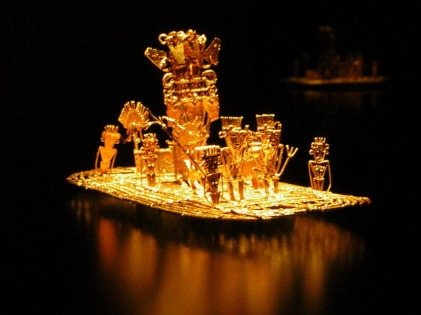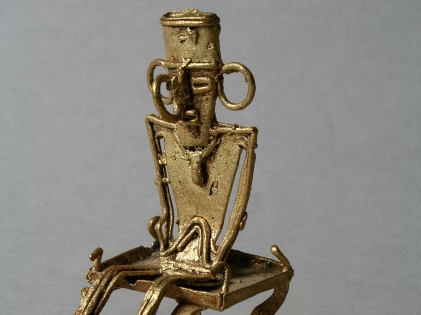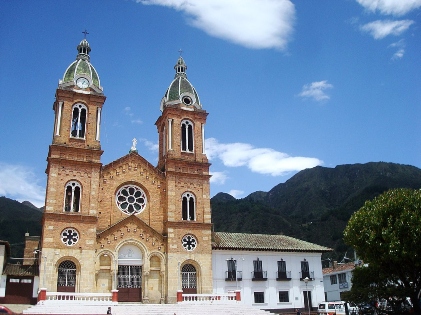You certainly have heard about El Dorado, haven’t you? Those fascinating legends about El Dorado have fascinated mankind over the centuries and it still continues to do so. But do you know exactly what El Dorado is and where it is located? The kings of the Muisca confederation, living in the northern Andes of what you know today as the country of Colombia in South America, were referred to as El Dorado. They inhabited that region between 600 and 1600. The name El Dorado is derived from the Muisca coronation ritual in which a new king used to get covered in gold dust before jumping into Lake Guatavita. As time progressed, the meaning of El Dorado extended to a mythical city. Later on, an entire region was referred to as El Dorado.
Gold and Its Significance in Ancient Colombia
 Talking about the culture that prevailed in ancient Colombia, gold used to be a popular material for people who worked as metalworkers. Though gold couldn’t be used as a currency, it had significance as a raw material used for exchange. In contrast to the other cultures in the Americas, it was not only the nobility who adorned gold. Even those belonging to the lower strata of the Muisca society.
Talking about the culture that prevailed in ancient Colombia, gold used to be a popular material for people who worked as metalworkers. Though gold couldn’t be used as a currency, it had significance as a raw material used for exchange. In contrast to the other cultures in the Americas, it was not only the nobility who adorned gold. Even those belonging to the lower strata of the Muisca society.
More than its intrinsic value, gold had more value because of its luster, workability, incorruptibility, as well as its significance in spirituality. The skilled artisans of the Muisca civilization came up with some incredible forms of art with the help of the goldsmith’s repertoire. The lost-wax technique was their specialty.
Gold and its Spiritual Associations
 The metal and its alloy artworks used to be offered in huge amounts to the gods. They were also buried at locations that were considered sacred by the people of the Muisca confederation. This was done to maintain the balance of the cosmos as well as avert any natural disaster. Included in the offerings given to god were tunjos. The figurines were represented in objects that people carried, such as weapons, shields, as well as musical instruments. A popular tunjo is a golden raft that was kept in a clay vessel that was discovered inside a cave. It is now kept in the Museo del Oro in Colombia’s capital, Bogota.
The metal and its alloy artworks used to be offered in huge amounts to the gods. They were also buried at locations that were considered sacred by the people of the Muisca confederation. This was done to maintain the balance of the cosmos as well as avert any natural disaster. Included in the offerings given to god were tunjos. The figurines were represented in objects that people carried, such as weapons, shields, as well as musical instruments. A popular tunjo is a golden raft that was kept in a clay vessel that was discovered inside a cave. It is now kept in the Museo del Oro in Colombia’s capital, Bogota.
The main objective of the exploration carried out by the Spanish government, driven by their inquisitiveness and thirst for gold, was to melt the metal down and ship them back to Europe as much as possible. The association of the valuable metal and ancient Colombia went on to be represented in Castillo del Oro, the name given by the Spanish king given to his new territory. Ancient Colombia was known for the widespread availability of gold and emeralds and the stories related to them fascinated the Spanish invaders, especially the one who narrated the lavish ceremonies that were performed while a Muisca king was crowned.
The Crowning of a New Muisca Monarch
As per the legend, when it was time to crown a new king, the man chosen to sit on the throne had to abstain from women, salt, and chili peppers for a certain period of time. With the advent of coronation day, the about-to-be king traveled to Lake Guatavita, located north of today’s Bogota. The main purpose was to give offerings to the gods and please them in order to receive their blessings. He had to reach the center of the lake on a raft that had golds and emeralds on it, along with four large incense burners. The clouds of thick smoke coming from the incense from the raft as well as those set around the lake’s shores created a mystique ambiance all around.
The would-be king covered his naked body with resin on which fine gold dust was blown. Amidst all the singing and the trumpets blowing, all the gold and jewels were thrown into the lake. Post that, the king would leap into Lake Guatavita and come up with all the gold washed away from his body, to become the king of the Muisca confederation.
Later History
 Several explorations to El Dorado took place in the later period. Gonzalo Jiménez de Quesada, the Spanish conquistador, discovered Lake Guatavita in 1537. He was on an expedition to the highlands located on the Eastern Ranges of the Andes mountains. He was searching for gold. Sir Walter Raleigh carried out his first expedition in search of El Dorado in 1595, but without success. He made his second attempt to find El Dorado. He was unsuccessful for the second time as well.
Several explorations to El Dorado took place in the later period. Gonzalo Jiménez de Quesada, the Spanish conquistador, discovered Lake Guatavita in 1537. He was on an expedition to the highlands located on the Eastern Ranges of the Andes mountains. He was searching for gold. Sir Walter Raleigh carried out his first expedition in search of El Dorado in 1595, but without success. He made his second attempt to find El Dorado. He was unsuccessful for the second time as well.
El Dorado went on to be known as the City of Gold. No explorer has been able to reach this place to date. It still remains a mystery to millions.





